Spatiotemporal Changes in the Quantity and Quality of Water in the Xiao Bei Mainstream of the Yellow River and Characteristics of Pollutant Fluxes
Abstract
:1. Introduction
2. Materials and Methods
2.1. Study Area
2.2. Runoff Data Collection
2.3. Water Sampling and Analysis
2.3.1. Sampling Sites and Procedures
2.3.2. Sample Collection and Determination
2.3.3. Quality Assurance
3. Results
3.1. Mainstream Section
3.1.1. Evolution of the Long-Term Runoff Series
3.1.2. Intra-Annual Variations in Runoff
3.2. Major Tributaries
3.2.1. Evolution of the Long-Term Runoff Series
3.2.2. Intra-Annual Variations in Runoff
3.2.3. Intra-Annual Contribution Ratios of Tributaries’ Runoff
3.3. Assessment of Water Quality
3.4. Changes in Pollutant Fluxes
4. Discussion
4.1. Temporal Variation in Runoff in the Xiao Bei Mainstream and Its Tributaries
4.2. Factors of Water Quality and Pollutant Fluxes
4.3. Agricultural Impacts and Policy Measures on Pollutant Loads in the Yellow River Basin
4.3.1. Effectiveness of Policy on Pollutant Loads
4.3.2. Soil Salinization and Water Quality
4.3.3. Dams and Water Quality
5. Conclusions
Author Contributions
Funding
Data Availability Statement
Conflicts of Interest
References
- Xie, F.; Yu, M.; Yuan, Q.; Meng, Y.; Qie, Y.; Shang, Z.; Luan, F.; Zhang, D. Spatial Distribution, Pollution Assessment, and Source Identification of Heavy Metals in the Yellow River. J. Hazard Mater. 2022, 436, 129309. [Google Scholar] [CrossRef] [PubMed]
- Zhu, Z. International Water Resources Association The Yellow River Basin: Water Accounting, Water Accounts, and Current Issues. Water Int. 2004, 29, 2–10. [Google Scholar] [CrossRef]
- Wang, S.; Fu, B.; Liang, W.; Liu, Y.; Wang, Y. Driving Forces of Changes in the Water and Sediment Relationship in the Yellow River. Sci. Total Environ. 2017, 576, 453–461. [Google Scholar] [CrossRef] [PubMed]
- Wei, J.; Lei, Y.; Yao, H.; Ge, J.; Wu, S.; Liu, L. Estimation and Influencing Factors of Agricultural Water Efficiency in the Yellow River Basin, China. J. Clean Prod. 2021, 308, 127249. [Google Scholar] [CrossRef]
- Zhang, X.; Yu, W.; Zhang, T.; Shen, D. The Influencing Factors of Water Uses in the Yellow River Basin: A Physical, Production-Based, and Consumption-Based Water Footprint Analysis by the Random Forest Model. Water 2023, 15, 170. [Google Scholar] [CrossRef]
- Chen, Y.-P.; Fu, B.-J.; Zhao, Y.; Wang, K.-B.; Zhao, M.M.; Ma, J.-F.; Wu, J.H.; Xu, C.; Liu, W.-G.; Wang, H. Sustainable Development in the Yellow River Basin: Issues and Strategies. J. Clean Prod. 2020, 263, 121223. [Google Scholar] [CrossRef]
- Shen, Y.; Guo, Y.; Guo, Y.; Wu, L.; Shen, Y. Evaluating Water Resources Sustainability of Water-Scarcity Basin from a Scope of WEF-Nexus Decomposition: The Case of Yellow River Basin. In Environment, Development and Sustainability; Springer: Berlin/Heidelberg, Germany, 2024. [Google Scholar] [CrossRef]
- Feng, K.; Siu, Y.L.; Guan, D.; Hubacek, K. Assessing Regional Virtual Water Flows and Water Footprints in the Yellow River Basin, China: A Consumption Based Approach. Appl. Geogr. 2012, 32, 691–701. [Google Scholar] [CrossRef]
- Zhao, M.M.; Wang, S.-M.; Chen, Y.-P.; Wu, J.-H.; Xue, L.-G.; Fan, T.T. Pollution Status of the Yellow River Tributaries in Middle and Lower Reaches. Sci. Total Environ. 2020, 722, 137861. [Google Scholar] [CrossRef]
- Wu, S.; Hu, Y.H.; Zuo, D. Discussion on Parameter Choice for Managing Water Quality of the Drinking Water Source. Procedia Environ. Sci. 2011, 11, 1465–1468. [Google Scholar]
- Maavara, T.; Chen, Q.; Van Meter, K.; Brown, L.E.; Zhang, J.; Ni, J.; Zarfl, C. River Dam Impacts on Biogeochemical Cycling. Nat. Rev. Earth Environ. 2020, 1, 103–116. [Google Scholar] [CrossRef]
- Wang, W.; Li, S.L.; Zhong, J.; Wang, L.; Yang, H.; Xiao, H.; Liu, C.Q. CO2 emissions from Karst Cascade Hydropower Reservoirs: Mechanisms and Reservoir Effect. Environ. Res. Lett. 2021, 16, 044013. [Google Scholar] [CrossRef]
- Xu, Y.; Yu, S.; Liu, D.; Ma, J.; Chuo, M. The Impact of the Three Gorges Reservoir Operations on Hydraulic Characteristics in the Backwater Region: A Comprehensive 2D Modeling Study. Water 2024, 16, 2045. [Google Scholar] [CrossRef]
- Shi, W.; Wang, W.; Yu, S.; Liang, L.; Zhong, J.; Yi, Y.; Li, S.L. Influences of Hydrodynamics on Dissolved Inorganic Carbon in Deep Subtropical Reservoir: Insights from Hydrodynamic Model and Carbon Isotope Analysis. Water Res. 2024, 250, 121058. [Google Scholar] [CrossRef] [PubMed]
- Jin, W.; Chang, J.; Wang, Y.; Bai, T. Long-Term Water-Sediment Multi-Objectives Regulation of Cascade Reservoirs: A Case Study in the Upper Yellow River, China. J. Hydrol. 2019, 577, 123978. [Google Scholar] [CrossRef]
- Ouyang, W.; Hao, F.; Song, K.; Zhang, X. Cascade Dam-Induced Hydrological Disturbance and Environmental Impact in the Upper Stream of the Yellow River. Water Resour. Manag. 2011, 25, 913–927. [Google Scholar] [CrossRef]
- Mu, J.; Zhang, H.; Liu, S.M.; Wu, N.; Song, G.; Ding, S.; Zhang, X. Nutrient Dynamics in the Yellow River—A Case Study of Different Reservoir Regulation Operations. J. Hydrol. 2024, 629, 130563. [Google Scholar] [CrossRef]
- Chapra, S.C.; Camacho, L.A.; McBride, G.B. Impact of Global Warming on Dissolved Oxygen and Bod Assimilative Capacity of the World’s Rivers: Modeling Analysis. Water 2021, 13, 2408. [Google Scholar] [CrossRef]
- Wang, Y.; Tan, D.; Han, L.; Li, D. Review of climate change in the Yellow River Basin. J. Desert Res. 2021, 41, 235. [Google Scholar]
- Liu, S.; Qiu, Y.; Fu, R.; Liu, Y.; Suo, C. Identifying the Water Quality Variation Characteristics and Their Main Driving Factors from 2008 to 2020 in the Yellow River Basin, China. Environ. Sci. Pollut. Res. 2023, 30, 66753–66766. [Google Scholar] [CrossRef]
- Sun, X.; Zhou, Z.; Wang, Y. Water Resource Carrying Capacity and Obstacle Factors in the Yellow River Basin Based on the RBF Neural Network Model. Environ. Sci. Pollut. Res. 2023, 30, 22743–22759. [Google Scholar] [CrossRef]
- Wang, X.; Duan, L.; Zhang, T.; Cheng, W.; Jia, Q.; Li, J.; Li, M. Ecological Vulnerability of China’s Yellow River Basin: Evaluation and Socioeconomic Driving Factors. Environ. Sci. Pollut. Res. Int. 2023, 30, 115915–115928. [Google Scholar] [CrossRef] [PubMed]
- GB 3838-2002; Environmental Quality Standard for Surface Water. Ministry of Ecology and Environment: Beijing, China, 2002. Available online: https://english.mee.gov.cn/standards_reports/standards/water_environment/quality_standard/200710/t20071024_111792.htm (accessed on 7 September 2024).
- Wang, H.; Sun, F. Variability of Annual Sediment Load and Runoff in the Yellow River for the Last 100 Years (1919–2018). Sci. Total Environ. 2021, 758, 143715. [Google Scholar] [CrossRef] [PubMed]
- Shi, C.; Zhou, Y.; Fan, X.; Shao, W. A Study on the Annual Runoff Change and Its Relationship with Water and Soil Conservation Practices and Climate Change in the Middle Yellow River Basin. Catena 2013, 100, 31–41. [Google Scholar] [CrossRef]
- Wang, S.; Yan, M.; Yan, Y.; Shi, C.; He, L. Contributions of Climate Change and Human Activities to the Changes in Runoff Increment in Different Sections of the Yellow River. Quat. Int. 2012, 282, 66–77. [Google Scholar] [CrossRef]
- Jiang, L.; Zuo, Q.; Ma, J.; Zhang, Z. Evaluation and Prediction of the Level of High-Quality Development: A Case Study of the Yellow River Basin, China. Ecol. Indic. 2021, 129, 107994. [Google Scholar] [CrossRef]
- Wang, B.; Wang, H.; Jiao, X.; Huang, L.; Chen, H.; Guo, W. Runoff Change in the Yellow River Basin of China from 1960 to 2020 and Its Driving Factors. J. Arid. Land 2024, 16, 168–194. [Google Scholar] [CrossRef]
- Xu, J.; Jiang, X.; Sun, H.; Xu, H.; Zhong, X.; Liu, B.; Li, L. Driving Forces of Nature and Human Activities on Water and Sediment Changes in the Middle Reaches of the Yellow River in the Past 100 Years. J. Soils Sediments 2021, 21, 2450–2464. [Google Scholar] [CrossRef]
- Qin, H.; Shi, H.; Gai, Y.; Qiao, S.; Li, Q. Sensitivity Analysis of Runoff and Wind with Respect to Yellow River Estuary Salinity Plume Based on FVCOM. Water 2023, 15, 1378. [Google Scholar] [CrossRef]
- Zhou, Y.; Ma, J.; Zhang, Y.; Qin, B.; Jeppesen, E.; Shi, K.; Brookes, J.D.; Spencer, R.G.M.; Zhu, G.; Gao, G. Improving Water Quality in China: Environmental Investment Pays Dividends. Water Res. 2017, 118, 152–159. [Google Scholar] [CrossRef]
- Ministry of Ecology and Environment the People’s Republic of China. Action Plan for Prevention and Control of Water Pollution Printed and Distributed; Ministry of Ecology and Environment the People’s Republic of China: Beijing, China, 2015. [Google Scholar]
- Wang, Y.; Zhao, W.; Wang, S.; Feng, X.; Liu, Y. Yellow River Water Rebalanced by Human Regulation. Sci. Rep. 2019, 9, 9707. [Google Scholar] [CrossRef]
- Zhang, Q.; Jin, Z.; Zhang, F.; Xiao, J. Seasonal Variation in River Water Chemistry of the Middle Reaches of the Yellow River and Its Controlling Factors. J. Geochem. Explor. 2015, 156, 101–113. [Google Scholar] [CrossRef]
- Zhao, M.M.; Chen, Y.; Xue, L.; Fan, T.T.; Emaneghemi, B. Greater Health Risk in Wet Season than in Dry Season in the Yellow River of the Lanzhou Region. Sci. Total Environ. 2018, 644, 873–883. [Google Scholar] [CrossRef] [PubMed]
- Ministry of Ecology and Environment the People’s Republic of China. 2017 Report on the State of the Ecology and Environment in China; Ministry of Ecology and Environment the People’s Republic of China: Beijing, China, 2018. [Google Scholar]
- Yue, F.J.; Li, S.L.; Liu, C.Q.; Zhao, Z.Q.; Ding, H. Tracing Nitrate Sources with Dual Isotopes and Long Term Monitoring of Nitrogen Species in the Yellow River, China. Sci. Rep. 2017, 7, 8537. [Google Scholar] [CrossRef]
- Hu, N.; Sheng, Y.; Li, C.; Li, Z.; Liu, Q. The Reactivity of Dissolved and Suspended Particulate Phosphorus Pools Decreases with Distance Downstream in the Yellow River. Commun. Earth Environ. 2023, 4, 294. [Google Scholar] [CrossRef]
- Chen, G.; Wei, Z.; Liu, H. Study on Soil Desalination Process of Saline-Alkaline Grassland along the Yellow River in Western Inner Mongolia under Subsurface Drainage. Sustainability 2022, 14, 14494. [Google Scholar] [CrossRef]
- Zhang, Y.; Yang, P.; Liu, J.; Zhang, X.; Zhao, Y.; Zhang, Q.; Li, L. Sustainable Agricultural Water Management in the Yellow River Basin, China. Agric. Water Manag. 2023, 288, 108473. [Google Scholar] [CrossRef]
- Cai, X.; Rosegrant, M.W. Optional Water Development Strategies for the Yellow River Basin: Balancing Agricultural and Ecological Water Demands. Water Resour. Res. 2004, 40. [Google Scholar] [CrossRef]
- Wang, S.; Fu, B.; Piao, S.; Lü, Y.; Ciais, P.; Feng, X.; Wang, Y. Reduced Sediment Transport in the Yellow River Due to Anthropogenic Changes. Nat. Geosci. 2016, 9, 38–41. [Google Scholar] [CrossRef]
- Yu, S. Modeling Phosphorus Cycling in a Seasonally Stratified Reservoir (Fanshawe Reservoir, ON, Canada). Master Thesis, University of Waterloo, Waterloo, ON, Canada, 2020. Available online: http://hdl.handle.net/10012/16346 (accessed on 7 September 2024).
- Scott Winton, R.; Calamita, E.; Wehrli, B. Reviews and Syntheses: Dams, Water Quality and Tropical Reservoir Stratification. Biogeosciences 2019, 16, 1657–1671. [Google Scholar] [CrossRef]
- Maavara, T.; Parsons, C.T.; Ridenour, C.; Stojanovic, S.; Dürr, H.H.; Powley, H.R.; Van Cappellen, P. Global Phosphorus Retention by River Damming. Proc. Natl. Acad. Sci. USA 2015, 112, 15603–15608. [Google Scholar] [CrossRef]
- Kao, N.; Mohamed, M.; Sorichetti, R.J.; Niederkorn, A.; Van Cappellen, P.; Parsons, C.T. Phosphorus Retention and Transformation in a Dammed Reservoir of the Thames River, Ontario: Impacts on Phosphorus Load and Speciation. J. Great Lakes Res. 2022, 48, 84–96. [Google Scholar] [CrossRef]
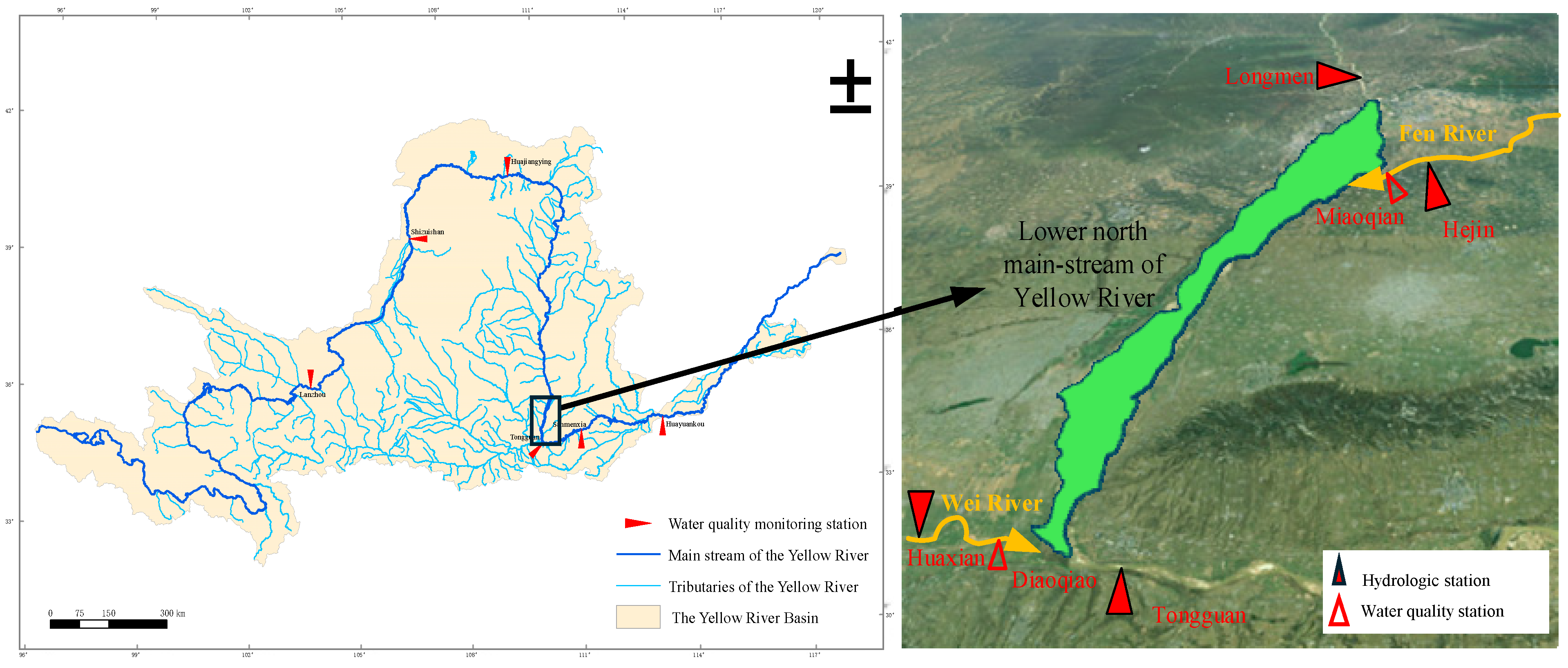
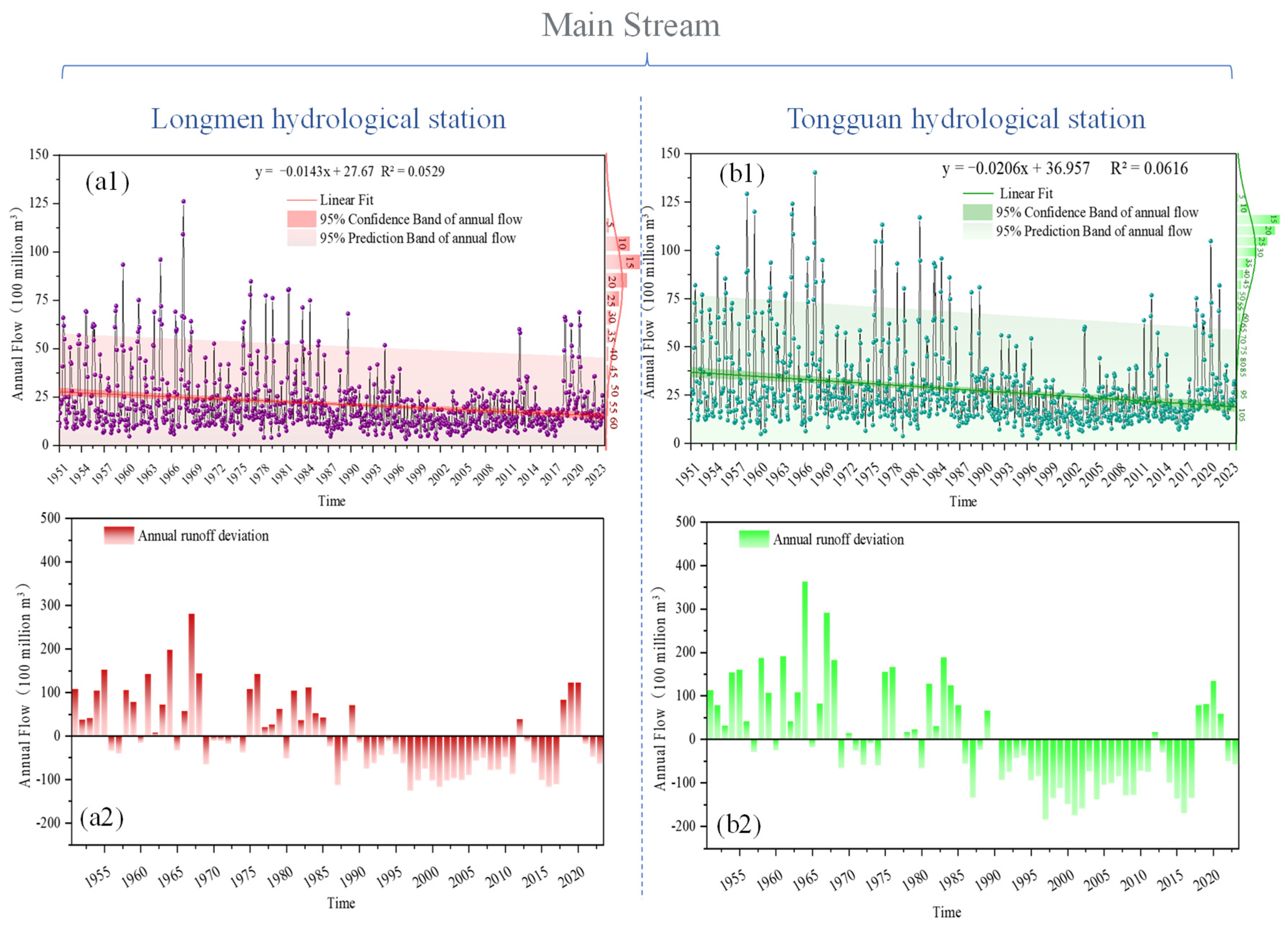
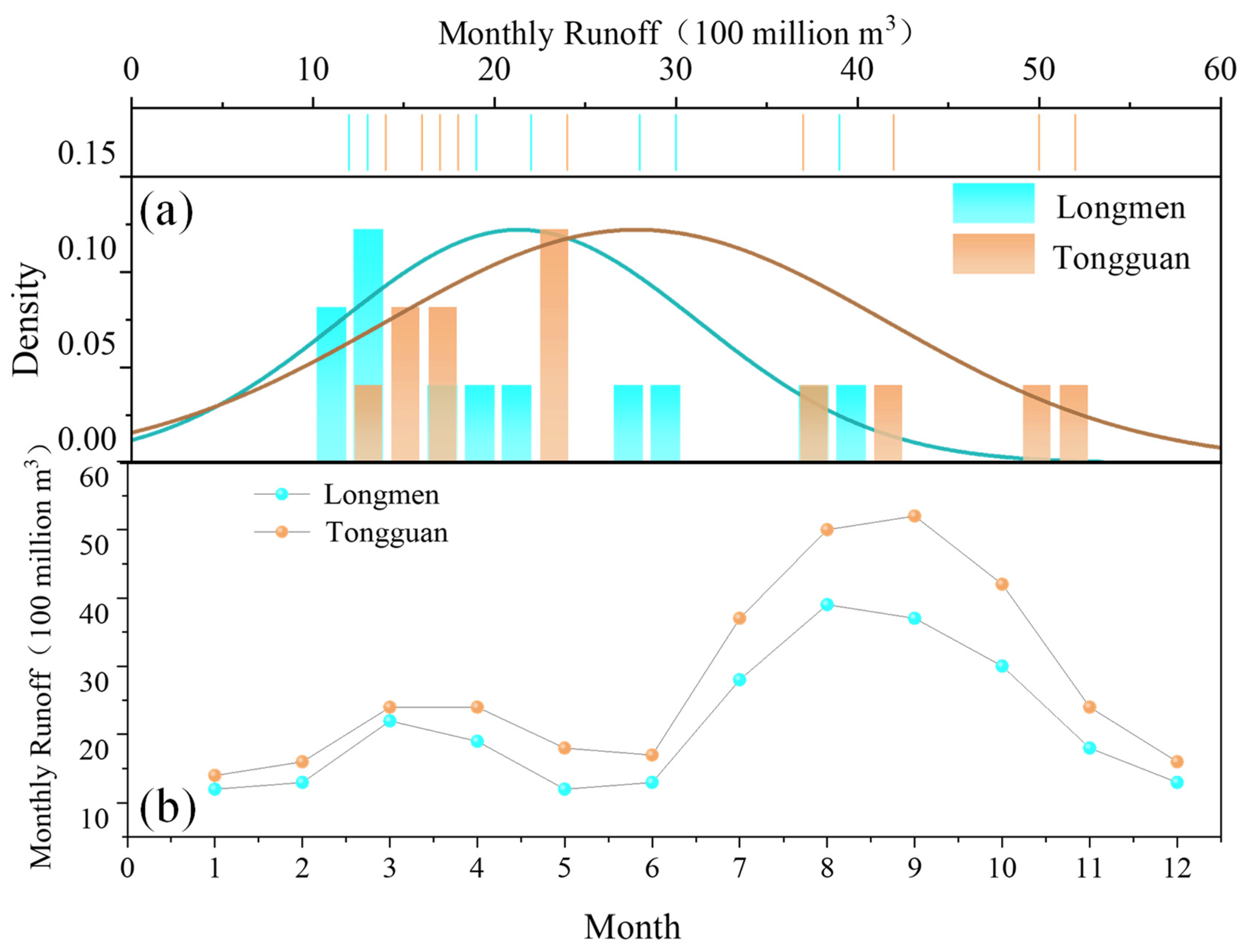
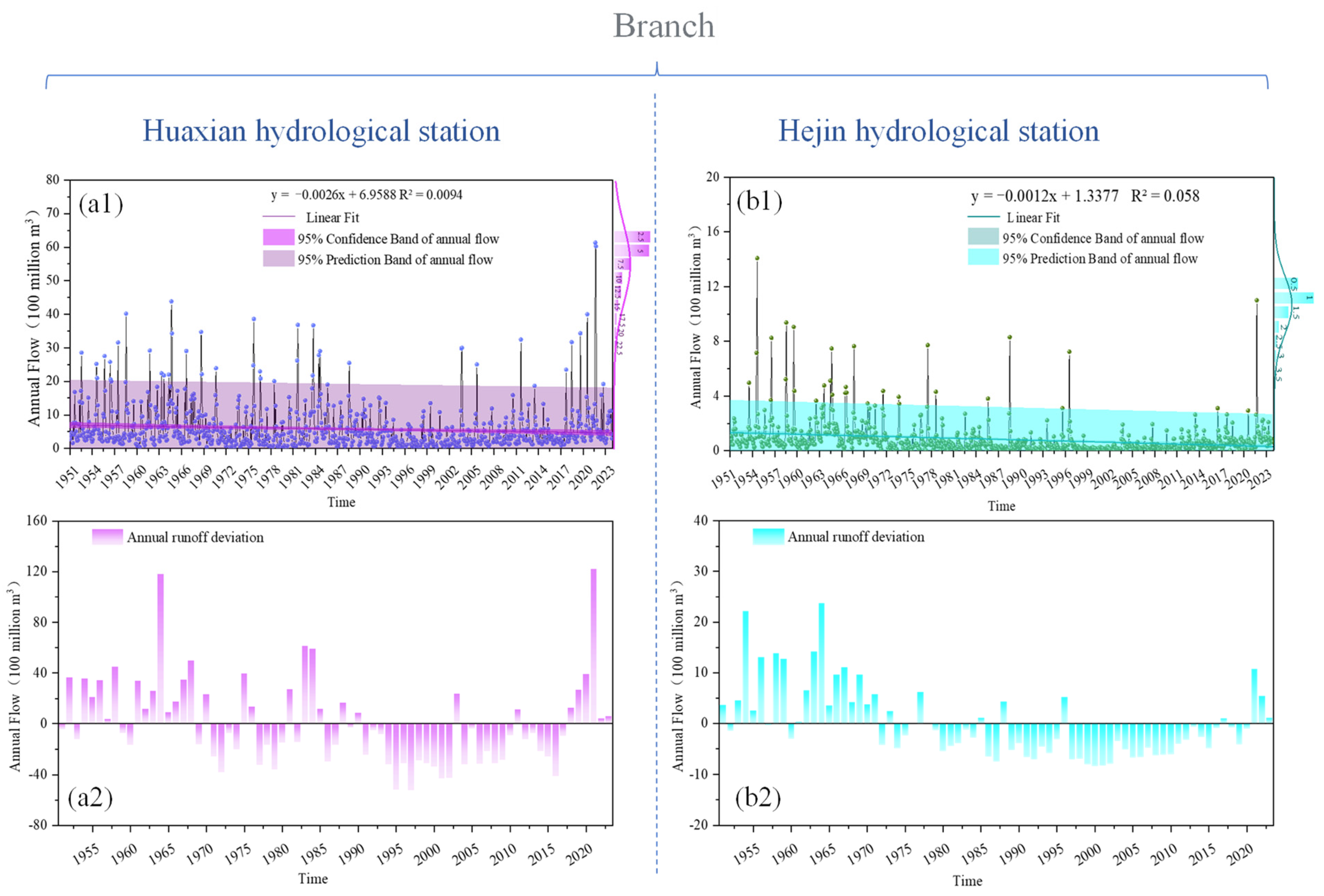
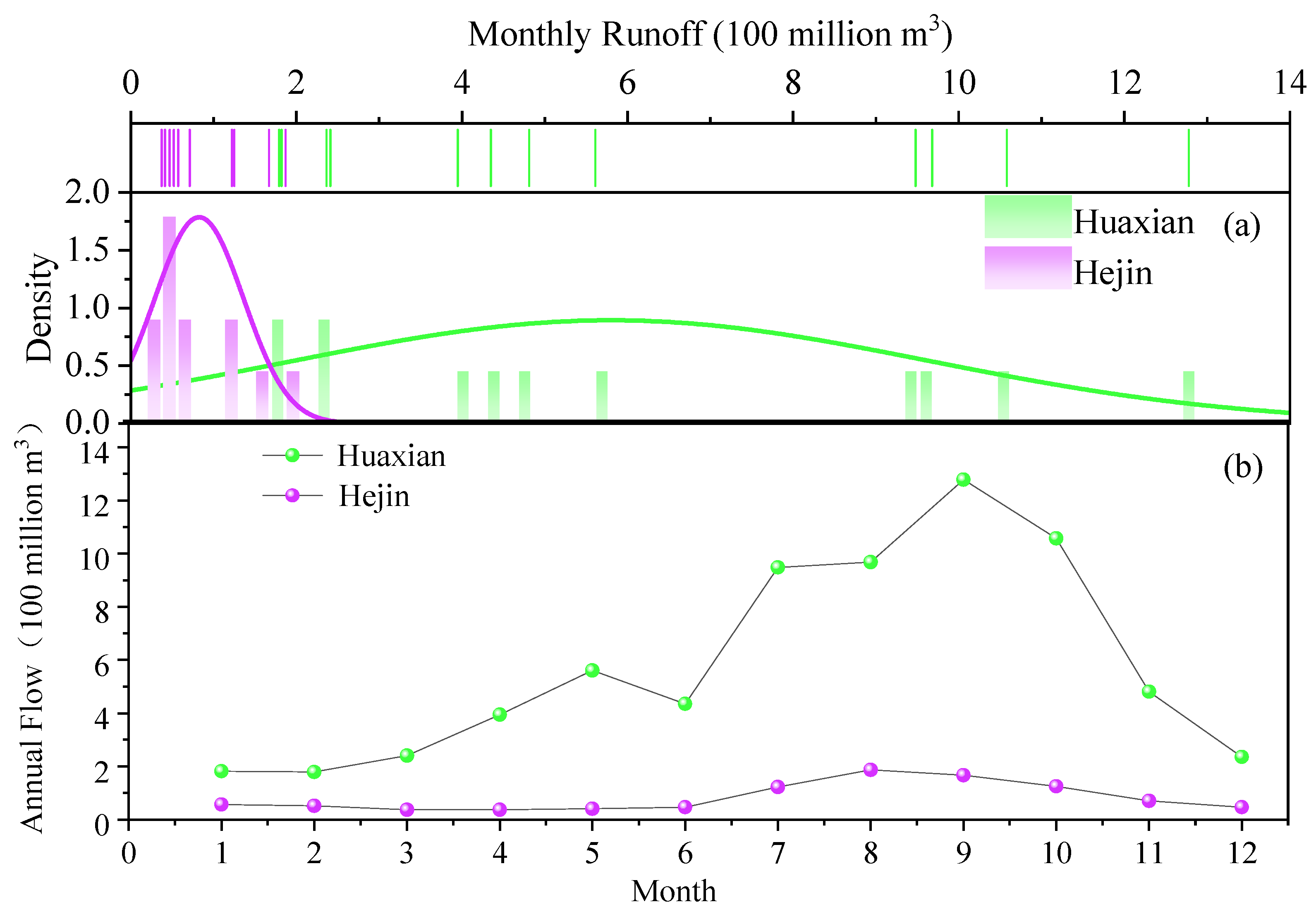
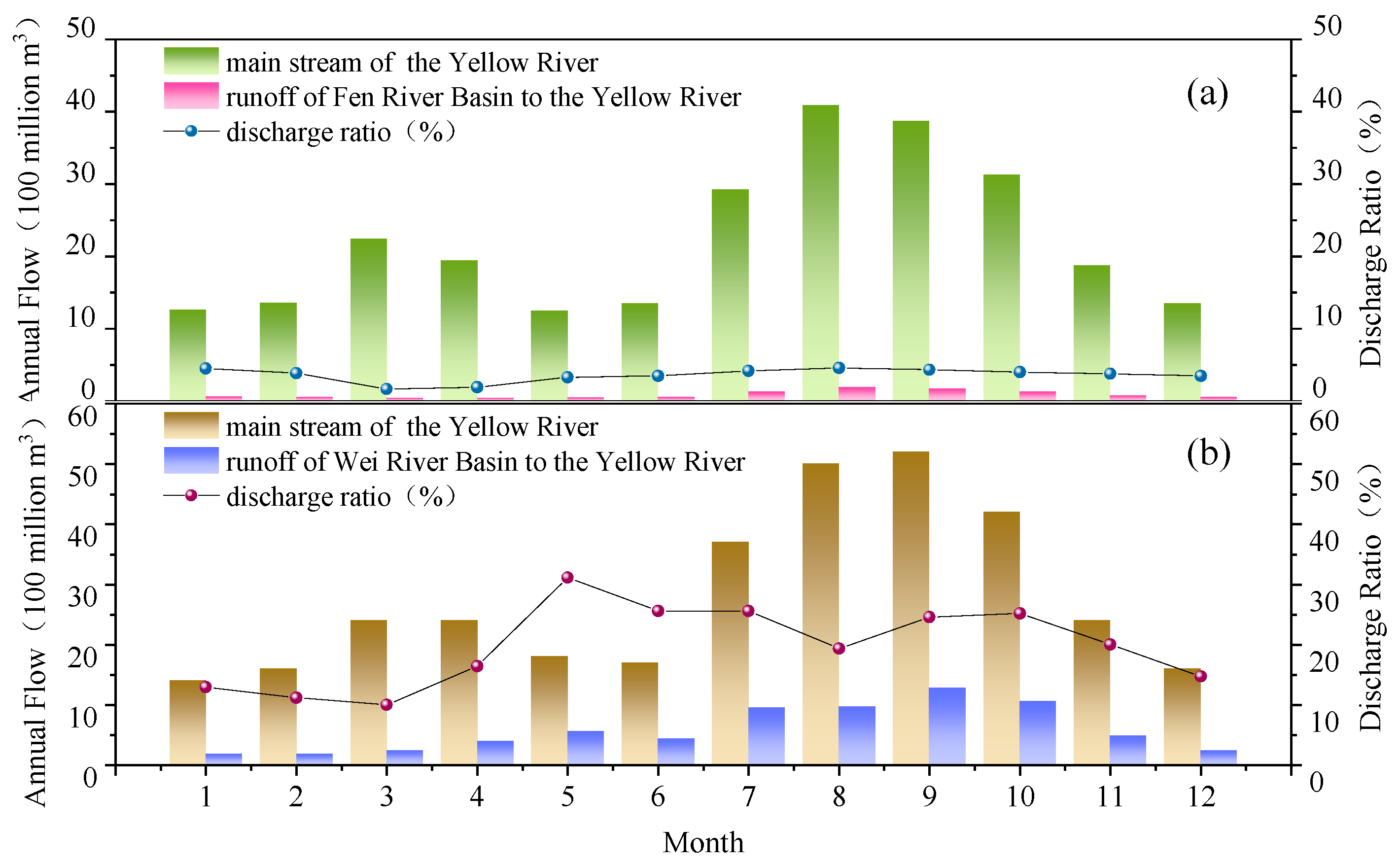


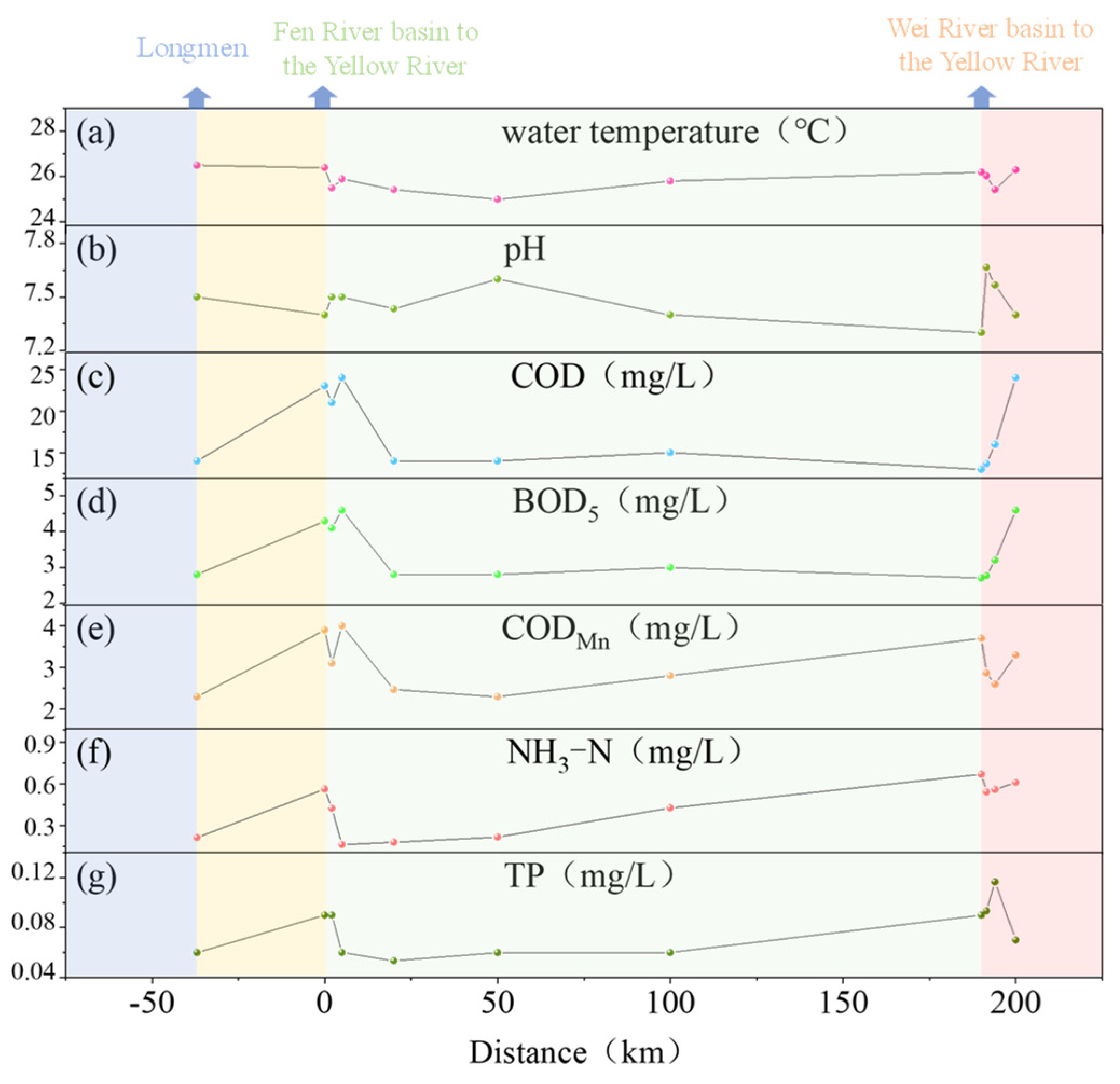

| No. | Monitoring Point | Latitude and Longitude | Relative Distance |
|---|---|---|---|
| 1 | Longmen | 110.60867786, 35.65471586 | −37 km |
| 2 | Fen River entry to Yellow River, 0 km | 110.46890259, 35.34281990 | 0 km |
| 3 | Fen River entry to Yellow River, downstream 2 km | 110.45306683, 35.33249239 | 2 km |
| 4 | Fen River entry to Yellow River, downstream 5 km | 110.44521332, 35.30496925 | 5 km |
| 5 | Fen River entry to Yellow River, downstream 20 km | 110.37466049, 35.13514167 | 20 km |
| 6 | Fen River entry to Yellow River, downstream 50 km | 110.32299042, 35.04194354 | 50 km |
| 7 | Fen River entry to Yellow River, downstream 100 km | 110.27518272, 34.61943546 | 100 km |
| 8 | Wei River entry to Yellow River section, 0 km | 110.28792858, 34.61049980 | 190 km |
| 9 | Wei River entry to Yellow River, downstream 1.5 km | 110.30397892, 34.60940485 | 191.5 km |
| 10 | Wei River entry to Yellow River, downstream 4 km | 110.33073664, 34.60912228 | 194 km |
| 11 | Wei River entry to Yellow River, downstream 10 km | 110.41276932, 34.58863340 | 200 km |
Disclaimer/Publisher’s Note: The statements, opinions and data contained in all publications are solely those of the individual author(s) and contributor(s) and not of MDPI and/or the editor(s). MDPI and/or the editor(s) disclaim responsibility for any injury to people or property resulting from any ideas, methods, instructions or products referred to in the content. |
© 2024 by the authors. Licensee MDPI, Basel, Switzerland. This article is an open access article distributed under the terms and conditions of the Creative Commons Attribution (CC BY) license (https://creativecommons.org/licenses/by/4.0/).
Share and Cite
Yu, Z.; Sun, X.; Yan, L.; Li, Y.; Jin, H.; Yu, S. Spatiotemporal Changes in the Quantity and Quality of Water in the Xiao Bei Mainstream of the Yellow River and Characteristics of Pollutant Fluxes. Water 2024, 16, 2616. https://doi.org/10.3390/w16182616
Yu Z, Sun X, Yan L, Li Y, Jin H, Yu S. Spatiotemporal Changes in the Quantity and Quality of Water in the Xiao Bei Mainstream of the Yellow River and Characteristics of Pollutant Fluxes. Water. 2024; 16(18):2616. https://doi.org/10.3390/w16182616
Chicago/Turabian StyleYu, Zhenzhen, Xiaojuan Sun, Li Yan, Yong Li, Huijiao Jin, and Shengde Yu. 2024. "Spatiotemporal Changes in the Quantity and Quality of Water in the Xiao Bei Mainstream of the Yellow River and Characteristics of Pollutant Fluxes" Water 16, no. 18: 2616. https://doi.org/10.3390/w16182616






